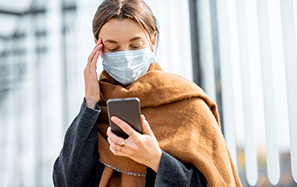Studies show that most infections are spread through aerosols. The crucial concept in aerosol contamination is the “viral dose”; the number of infectious virus particles needed to infect another person. The more particles you inhale, the sicker you get. This article presents a set of guidelines to prevent infection.
Lees volledig artikel: How you get infected by aerosols and what you can do about it
How you get infected by aerosols and what you can do about it
Fortunately, due in part to the publicity surrounding the letter from the 239 scientists to the WHO, more and more people are recognizing that aerosols are an important source by which people are infected. On April 2nd I wrote this about it and on April 18th I spoke about it at Op1. Superspread events are the driving force behind the pandemic and I have shown here that the vast majority of the infections are related to it.
Studies and logic show that with superspread events, it just can’t be otherwise that airborne infections were the cause. This database contains 500 of these events worldwide, each one infecting more than 100 people. It is completely illogical to think that these people have been infected via direct contact with an infected person.
Prof. Streeck’s research in Heinsberg also gives strong indications of this.
The fact that 10% of the infected people account for 80% of the infections, 20% for 20% and 70% for 0%, as established by Adam and Cowling, leads to a number of important conclusions:
– Apart from superspread events, the risk of being infected is not so great. Contact studies worldwide show that only 10% to 35% of the housemates of infected people are infected. So the vast majority of housemates are not infected by a patient at home.
– At superspread events, many are infected at the same time, and the research in Heinsberg shows that you then become much sicker than if you were infected at home. (There they had 1.6 times as many symptoms and at home 36% of the infected persons had no symptoms at all and at Carnival 16%).
In fact, there are three possible routes of infection. The above figures, but also many other studies on Covid-19, as well as animal tests carried out with influenza, indicate the following:
– The chance of being infected by touching surfaces on which a patient has left the virus is (very) small. In any case, much smaller than many people in the Netherlands think. (The American RIVM has also scaled down this threat).
– The chance of being infected because an infected person coughs, sneezes or otherwise releases the virus in your face within 1.5 meters, sis much smaller than many people think.
Droplets
First of all, the droplet(s) have to float in a place where the virus can strike the other person at all (and that is the nose in particular). And that chance is really not as big as this study shows.
Then the virus must be able to multiply in the body. And it is stated in the literature that it is really not the case that, if the virus has gotten into the nose, one will certainly get sick. On the one hand, it may be that the body removes the virus in the direction of the esophagus. On the other hand, if there are too few virus particles in that drop, the body may be able to repel the attack of the virus. Wells showed this already in 1955.
That this is the case is supported by the observations, that apparently 70% of people do not infect anyone else. So even if you spend days together with a patient in your household, the vast majority of those housemates are not infected yet.
– The dominant way to get infected is by air and there are more and more studies that say so, like this one. I myself think I can show that this is in 95% or more of the cases. But even if you think it is only half, like Prof. Christian Drosten, the advisor of Merkel, the following is equally important.
Rare?
WHO/RIVM maintain, that aerogenic contamination is very rare, but that just doesn’t fit the phenomenon that during superspread events so many people are infected at the same time. And realize that a superspread event is already classified as such when more than 7 people are infected in a location at about the same time.
And if you still think that the aerosols are unimportant, you can stop reading here.
Already in 1955 Wells showed that the inhalation of aerosols by laboratory animals, to his own surprise, led to much more extensive damage to lungs than if it went via larger droplets. His explanation is very logical. If the disease mainly affects the lower respiratory tract (the lungs), which is the case with Covid-19, and the virus that enters the body nestles directly in the lungs, then that is the best place for the virus to strike. (A virus like HIV strikes in a completely different place and is transmitted in a completely different way).
You often notice that people think that if you only come into contact with one particle of the virus, you will automatically become infected and become quite ill. Luckily, that’s not true. The human body is built to repel all kinds of “attacks” of viruses and bacteria and usually does that very well. But sometimes that attack is so big for the body that it doesn’t succeed in repelling it. This has to do with the size of the attack as well as the condition of a person’s body to repel it. And that also makes a difference per disease.
Antibodies
For Covid-19 we now know that a large number of people have built up antibodies, without noticing any symptoms of the disease. Exactly what this figure is, is still under discussion, but seems to be somewhere between 30 and 50%. (In the meantime, the WHO has indicated that people without symptoms are apparently not able to infect others either).
What the exact ratio is between being infected and dying is also not yet known. But after figures of 3% from the RIVM, you now see figures that are (well) below 0.5%. And then it’s mainly people over 70 and mostly with underlying suffering. Of the people in the Netherlands who died from this disease, less than 10% were younger than 70 years of age (and most of them had underlying suffering).
This is very important to realize, so that you also better understand what risks you do or don’t run.
The crucial concept in aerosol contamination is the “viral dose”; the number of infectious virus particles needed to infect another person. That number is not known, but for the purposes of the explanation below, let’s link a number to it. Let’s say that 1,000 infectious virus particles are needed to infect person A in his lungs in such a way that he gets symptoms of that disease. (For person B this can be a higher or lower number).
Inhale
Two components are then important to reach that number of 1,000. How many infectious virus particles are in the air of the room where you are present and how long you spend in that room. This can be found in the interesting article by Prof. Bromage.
So if you inhale 10 infectious particles per minute then you have to inhale 100 minutes to reach that limit of 1,000 virus particles. If you breathe in 20 per minute, you reach that limit after 50 minutes.
Now there is good news:
If you watch superspread events, there are strong indications that you have to be present for a while and breathe in the virus before it can make you sick. Even in places where you might think there must have been quite a bit of virus in the air, it seems to have taken more than half an hour to breathe in enough virus to get sick. (But as I said, that also makes a difference per person, because the elderly will have reached that limit sooner than the young). And in places where there has been little virus in the air, it would have taken (much) more than 1 hour to become ill.
With that as input we can both indicate a policy to ensure that this form of infection is prevented as little as possible, and what approach you should follow to ensure that you are not infected in this way.
Preventing this type of infection
These are interior spaces where many people are present at the same time, who normally don’t meet each other or don’t meet often. This does not apply to yourself at home, if no strangers come there. In the latter case, however, there are precautions to take, which I will mention at the end of this blog.
– Make sure that the air in a room is refreshed as much as possible. Then the virus particles will be expelled. This can be done by good ventilation (windows / doors open against each other and / or an HVAC system that brings in a lot of fresh air).
– Adding something to an HVAC system that removes the virus from the air: (filters or other tools. (That’s why I propose a Delta Plan Ventilation, both to ensure sufficient fresh air and to take the virus out of the air).
– If the above cannot be done (well), then make sure that the people present in a confined space don’t or don’t bring a lot of aerosols into the air. This means applying restrictions with regard to singing / shouting / talking and/or wearing mouth protection.
– Research has also shown that if the relative humidity in that room is somewhere between 40% and 60%, the virus will float in the air for the shortest time. This can be seen on this site where doctors call for this humidity to be maintained.
Contagious
However, it is important to take into account that the danger can only arise if there is someone present who is contagious. That is someone who is infected himself, perhaps asymptomatic, but who apparently feels good enough not to stay at home.
At the moment in the Netherlands there are – fortunately – very few such people, so the risk of being present in a room, where you can breathe in contagious virus for a while, is very small.
Be aware that in the slaughterhouses the major outbreaks have come mainly because people work in places where the temperature is kept low – below 10 degrees – and there is little ventilation. This combination is the ideal condition for the aerosols to stay in the air for a long time. The present outbreaks in warm countries where many air conditioners are used, such as the southern states of the US and various countries in the Middle East, are also strongly related to this.
In the autumn, there is a much greater risk in the Netherlands that there will be situations where the virus is in the air to be inhaled. This is due to the colder temperatures and lower humidity (in grams of water per kilo of air). And that human activities will go more indoors. That was the situation with the large outbreaks in the Netherlands that occurred in the 4 weeks after 25 February. Recognize that based on the number of hospitalizations at the end of March, the number of new infections per day must have been between 25,000 and 50,000.
Infectious people
And where a large proportion of the residents of care institutions have become infected, it is more likely that this has happened because the virus has been distributed to the residents via the ventilation system than it was because infectious people without mouth protection have come into contact with the residents.
The proposed Delta Plan Ventilation serves to ensure that the conditions that could lead to superspread events in the coming winter will disappear from the Netherlands.
Preventing yourself from becoming infected
Until the end of September, the risk of being in a room in the Netherlands with someone who can infect others is very small. But after that, that chance will clearly increase.
If the Ventilation Delta Plan would be carried out, we would know which confined spaces are Corona proof. So there is no risk of being infected by aerosols in those areas. All activities can therefore take place there normally.
If a room is not Corona proof then there are a number of important points to take into account.
– Keep windows or doors crossways open, allowing fresh air to come in from the outside and the aerosols filled air to flow out.
– If this is not possible:
Ensure that all persons present wear mouth protection (as in public transport).
Make sure you don’t sing, shout or talk a lot.
Don’t stay too long in that room and (especially if you belong to a vulnerable group) wear mouth protection yourself.
The more rooms that are Corona proof, the less normal life is hindered and the lower the risk of outbreaks, with all kinds of undesirable consequences (such as regional lockdowns, etc.).
That’s why I think it’s so important to start with that Ventilation Delta Plan, in which all interior spaces with HVAC systems can be given a Corona proof stamp, which is also visible to those present. So that they know what their risks are and how they can behave there.
The home situation
Aerosols can also play a role in the infection at home, but then of course there is a very important condition: that there is someone at home who can infect others.
That will be so little the case by now, that you won’t have to worry about this virus in the air when you’re alone with your housemates.
Only when others enter your home, especially in autumn or winter, is there (slightly) more risk. You can reduce that risk by providing fresh air and/or bringing the humidity to a level between 40% and 60%.
And if you are still worried, don’t make the time spent together too long, or wear mouth protection. Or do the activity outside (in the garden, on the balcony, in the park).
Caring for the expulsion of air by fresh air from outside is the best strategy here.
Keep trying to realize how small the risks are. Especially in the coming months. You will ruin your own life if you are constantly afraid of something for which the chance of it happening is so small. Because even if you become infected, the chance that you will become very ill or die is also small. I have older people in my circle of acquaintances who are so afraid of being infected that I think that that fear is a greater risk to their health than the real risk of becoming very ill or dying of Covid-19.
By knowing how big/small your risks are, in which places and when your risks are bigger and smaller, you can best live in a world where Covid-19 will be among us for quite a while. (Especially if WHO/RIVM persists in not taking the right measures to prevent infections).
You have just read: How you get infected by aerosols and what you can do about it.







